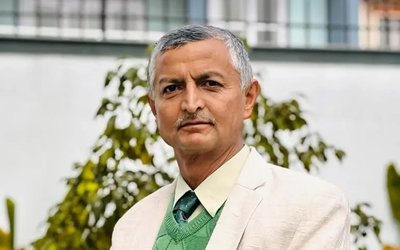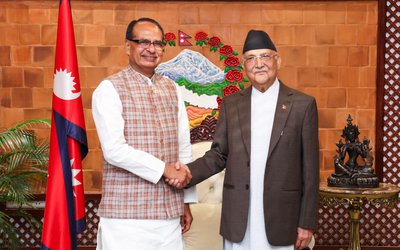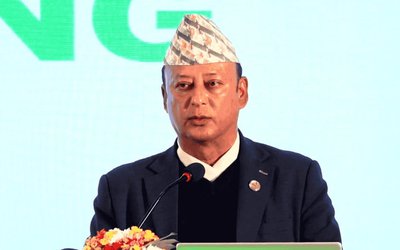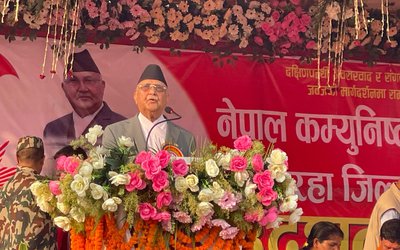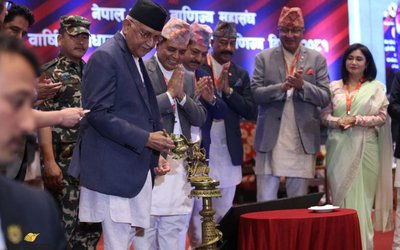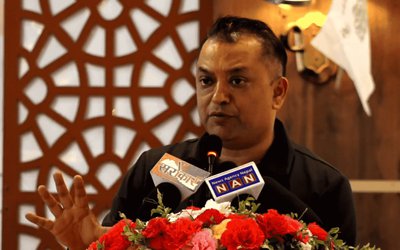
By KESHAB POUDEL in Rashuwagadhi
The devastating earthquake of April 25turned Rasuwagadhi, a site of hectic activities spurred by the 111-MW Rasuwagadhi Hydropower Project, 150 kilometers north of Capital Kathmandu, on the border with Tibetan Autonomous Region of China, into a ghost city.
With the opening of the border point for trade, which is now the only operational trading point between Nepal and China, Rasuwagadhi has come back to life again -- but there is no sign ofthe hydropower project resuming soon.
Frequent aftershocks forced the construction workers to leaveRasuwagadhiand the project eventually shut down its operations as the office buildings had been damaged. The construction site occupied by the project is now used for customs yards.
With the situation stabilizing, following the opening ofRasuwagadhi-Syaphrubeshi track, the construction companies and employees of the Rasuwagadhiproject have returned to the field.
Even as the project is now in the take-off stage, with the contractorsin ready gears, the resumption of construction is still uncertain as Nepal Oil Corporation hasyet to supply the diesel required for its operation.
“Once the NOC supplies us diesel as agreed with us, the project will resume anytime soon. We require at least 6000 liters of diesel per week,” said Madhav Prasad Koirala, Chief Executive Officer of Rasuwagadhi Hydropower Company. “If the construction work starts normally, it will be completed in four years.”
When prime minister K.P. Sharma Oli and deputy prime minister and Minister of Energy Top BahadurRayamajhi are issuing statements that the loadsheddinghours will come to an end by a year, the construction of this and allother hydropower projects are halted one way or the other.
Not only RasuwagadhiHydroproject, but also other three hydropower projects promoted by Chilime Hydropower Company, namely, 102 MW Middle Bhotekosi, 42.5 MW Sanjen and 14.8 MW Upper Sanjen projects are facing a similar situation.
The earthquake of April 25 and subsequent aftershocks disrupted the projects and now they are unable to resume work because of shortage of diesel and other construction materials.
NEA’s Project
Similar is the situation with projects under the construction of Nepal ElectricityAuthority. Takethe case of 407 MW Upper Tamakosi, Nepal’s largest hydropower project. With the shortage of diesel, the projects'activities to maintain the road to headwork and other activities are yet to resume.
“We are ready to resume the work. As soon as the project receives diesel, it will resume construction work,” said chief of Upper Tamakosi Company. “We are waiting now to see the fulfillment of the commitment made by Nepal Oil Corporation to provide diesel.”
Upper Tamakosi has already completed over 70 percent of the work. As the earthquake has damagedthe dam slightly, it is likely to delay the project by a couple of years.
Despite its commitment to complete the project by 2015, Kulekhani III hydropower project is likely to see a delay for another year due to complications and shortage of diesel.
Chameliya, another hydropower project with 35 MW, is likely to see a delay despite the completion of over 90 percent of its work. Although NEA was asked to release the money to complete the squeezed parts of the tunnel by Public Accounts Committee, it is uncertain whether NEA release budget or not.
Had NEA paid the money as agreed upon a settlement formula developed by then secretary of Energy Hare Ram Koirala’s team in 2012, Chameliya would have produced electricity almost two years ago.
Likewise, the construction of 120 MW Tanahu Hydropower Project is also likely to get delayed given the current situation.
Private Sector
The situation is no different at all with the private sector. In case of resumption of supply of petroleum products and other construction materials, there will be additional power of over 175MW, including 45 MW Bhotekosi.There is a possibility to have 100 MW from new and 75 MW from maintained projects.
Constructed under Sino-Hydro and Sagarmatha Hydro Company, 50 MW Upper Marsyangdi A is close to complete its construction. Similarly, there are many other projects in the pipeline.
“There is no sign of ending load-shedding by next years given the present planning of NEA,” said Bikash Thapa, energy journalist working with Annapurna Post Daily.
Pressure on NEA Greed
As there is a short supply of LPG,the pressure on the grid of Nepal electricity goes up resulting on the massive damage in the electricity supply infrastructure, including transformers. As the use of induction heaters goes up, Nepal’s old electricity system cannot sustain the load.
From beginning of October to end of December, Nepal Electricity Authority's infrastructure in Kathmandu valley was completely dysfunctional. Withhalf of the electricity consumed by consumers of Kathmandu valley, there is a lot of pressure on even load distribution.Surge in power demand is taking a toll on NEA's distribution system.
The foremen and other junior technical staffs have a difficult time now as they have to climb hundreds of poles to check the condition of 100 kv Transformers.
Of late, electricity transformers are receiving a huge load as households are waiting for load-shedding hours to end so that they can use electricity to cook, pump water and warm up their homes, among others.
As people use electric appliances all at once, transformers and cables with definite capacity cannot resist load and, hence, explode. The growing demand for electricity due to shortage of cooking fuel was causing transformers to catch fire.
Though foremen are not allowed to repair transformers at the site, they have been repairing transformers on the pole itself to restore electricity supply at the earliest.
Technical experts say the problem can be resolved by replacing the 100kv transformers with the 150kv capacity transformers.
According to NEA officials, an average of eight transformers catch fire in Kathmandu Valley every day. More than damaged 550 transformers have been sent to Lainchaur-based workshop for repairs, they said.
"Complaints from consumers have increased by around tenfold in recent weeks. Most of our technicians have fallen sick as they have to work for up to 18 hours a day throughout the week,”saidRam Chandra Pandey, chief of NEA's Distribution and Consumer Services Directorate. “Distribution system in residential areas has seen recurring overload in the past few weeks.”
“If we want to improve the situation, NEA should revamp its distribution system as existing system cannot resist demand load which has nearly doubled,” said Pandey.
NEA is also running out of repair materials including copper wires. According to NEA, 108 transformers have caught fire and more than 300 incidents of cables catching fire have been reported in the last two weeks. Similarly, more than 3,000 fuses and 157 MCBs have been damaged during the period.
The state-owned power utility is also facing shortage of transformers as its consignment has been stuck at Nepal-India border as well as Kolkata port since the blockade started.
The volume of workdemands has come down following the recent announcement of new load shedding schedule with more than 11 hours of power cut. “Our infrastructures are not in a position to cope with the present pressure. Thus, we faced a lot of problems and spent a lot of time in maintenance,” said Ram Chandra Pandey, deputy managing director Distribution and Consumer Services Directorate.
According to NEA, the annual peak power demand of the integrated Nepal Power System (INPS) was 1291.80 MW with 585 MW load shedding. Out of actually power supplied, 357.68 MW contributed by NEA hydro, 124.71 MW by IPP hydro and the rest 224.21 MW was imported from India. According to NEA, the annual demand of energy in NEA is 8 percent annually. As there is the lack of electricity in the grid, NEA has resorted up to 13 hours of load shedding to meet the supply.
Old Infrastructure
As the infrastructure built in Kathmandu is almost a decade old, there is a risk of disruption in the peak demand time as the transformers and other electric systems are incapable to supply power to meet it.
“Nepal electricity has not brought any newequipment. Our infrastructure cannot to meetthe peak demand and there is manpower constraint as well. NEA used to receive an average of 100 complaints from customers. With the sudden increase of pressure, everything went out of order with more than 1500 complaints a day now,” said Pandey. "As we focus on the maintenance and improvement of capacity, the situation is improving.”
Although almost all distribution centers receive a massive pressure, NEA’s Baneshwor distribution has faced the worst. With the 60,000 consumers, Baneshwor is over saturated.
“It was really a tough time for us. I could not sleep in the night. Every minute our no light section received telephone calls one after another. With no diesel, we were in no position to send the maintenance team. However, we have managed to keep the electricity supply to our consumers,” said Tek Nath Tiwari,” chief of NEA Baneshwor Distribution Center. "Our center alone upgraded over20transformers."
As the load fluctuates, many consumers have lost the household power systems and electric devices, including bulbs, plugs, television sets and so on, adding further economic burden.
Import of Additional Energy
As there is no immediate sign to increase the electricity production, Nepalhas decided to import an additional 90 MW of electricity from India by January-end after the completion of a key inter-country transmission line.
According to NEA, this will help maintain the current level of daily 12-hour load-shedding in its major cities. “If we cannot import the electricity, the load shedding hour may go up to 14 hours,” said Deputy Prime Minister and Minister of Energy Top Bahadur Rayamajhi.
Nepal is facing acute shortage of energy in the wake of the blockade of the Indo-Nepal border by Madhesis. Many people in the urban areas are relying on electricity due to the shortage of LPG and diesels.
Nepalis now importing 235 MW electricity from India through cross-border transmission lines.The transmission of additional power from India would be possible with the completion of the 400-KV Dhalkebar-Muzaffarpur transmission line, said Kanaiyalal Manandhar, chief of the transmission line department of Nepal Electricity Authority (NEA).
Appearing before parliament's Water Resources and Agriculture Committee, Minister Rayamajhi furnished details on the present power supply situation in Nepal and steps to cope with the deepening energy crisis.
Though hydroelectricity projects in Nepal are currently producing 780 MW electricity, it is inadequate to meet the domestic demand.
Although Nepal’s political leaders are selling their dream saying that Nepal will be rich by exporting the electricity to India, the state of Nepal’s electricity shows otherwise. With restriction of supply of electricity by India, Nepal’s power sector will completely collapse.
As Nepal’s political situation is in a mess and there is no immediate hope for resumption of supply of petroleum products due to the disruption in the border, Nepal’s hope to ease the load shedding seems to be a merely a dream.
“Our government will ease the load shedding by next year completing the construction of all the major hydro power projects,” thundered Prime Minister K.P. Shrama Oli. “Believe me there will be no load shedding next year.’
Load shedding cannot be completely wiped out as Prime Minister Oli says. However, the power supply can be improved if the government gives priority to complete the ongoing projects like Rasuwagadhi and Upper Tamakosi.
As there is no new project to be completed on the pipeline and even the projects which are in the process of completion are facing the problem of power evacuation due to the absence of transmission lines, Nepal will have to go as it is at least for a decade before itsees its load shedding hours easing and fewer people living without electricity.

Keshab Poudel
Poudel is the editor of New Spotlight Magazine.
- PM OLI MEETS PM MODI: No Progress
- Apr 09, 2025
- PM OLI’S THAILAND VISIT: Flip Flop
- Apr 08, 2025
- FM Dr. Deuba’s India Visit: Mission Aborted
- Mar 26, 2025
- AMBASSADOR MAEDA TORU: Warm Regards
- Mar 24, 2025
- PRO-MONARCHY MOVEMENT: Rising Dissatisfaction
- Mar 23, 2025
